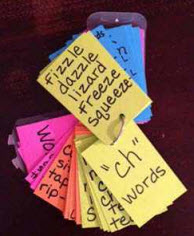
Phonemic Awareness is defined as the ability to identify, hear, and work with the smallest units of sound known as phonemes. It is NOT the same as phonological awareness, instead, it is a sub-category of phonological awareness. For example, phonemic awareness is narrow, and deals only with phonemes and manipulating the individual sounds of words – such as /c/, /a/, and /t/ are the individual sounds that make up to form the word “cat”. Phonological awareness on the other hand, includes the phonemic awareness ability, and it also includes the ability to hear, identify, and manipulate larger units of sound such as rimes and onsets.
Phonemic awareness can be taught very early on, and will play a critical role in helping children learn to read and spell. While it’s not set in stone on when a child can learn to read, however, I do believe that a child that can speak is a child that can learn to read. Children as young as two years old can learn to read by developing phonemic awareness, and they can learn to read fluently.

Below are several of the most common phonemic awareness skills that are often practiced with students and young children:
Phonemic identity – being able to recognize common sounds in different words such as /p/ is the common sound for “pat”, “pick”, and “play”.
Phonemic isolation – being able to recognize the individual sounds of words such as /c/ is the beginning sound of “cat” and /t/ is the ending sound of “cat”.
Phoneme substitution – being able to change one word to another by substituting one phoneme. For example changing the /t/ in “cat” to /p/ now makes “cap”.

Word Segmenting – the parent says the word “lap”, and the child says the individual sounds: /l/, /a/, and /p/.
Oral blending – the parent says the individual sounds such as /r/, /e/, and /d/, and the child forms the word from the sounds to say “red”.
Studies have found that phonemic awareness is the best predictor of reading success in young children. Research has also found that children with a high level of phonemic awareness progress with high reading and spelling achievements; however, some children with low phonemic awareness experience difficulties in learning to read and spell. Therefore, it is important for parents to help their young children develop good phonemic awareness.

Being able to oral blend and segment words helps children to read and spell. According to the National Reading Panel, oral blending helps children develop reading skills where printed letters are turned into sounds which combine to form words. Additionally, word segmenting helps children breakdown words into their individual sounds (phonemes), and helps children learn to spell unfamiliar words.

As a young child begins to develop and master phonemic awareness skills, they will discover an entirely new world in print and reading. You will open up their world to a whole new dimension of fun and silliness. They will be able to read books that they enjoy, develop a better understanding of the world around them through printed materials, and have a whole lot of fun by making up new nonsense words through phonemic substitutions.

For example, we taught our daughter to read at a young age – when she was a little over 2 and a half years old. Before she turned three, she would run around the house saying all types of silly words using phonemic substitution. One of her favorite was substituting the letter sound /d/ in “daddy” with the letter sound /n/. So, she would run around me in circles and repeatedly say “nanny, nanny, come do this” or “nanny, nanny, come play with me” etc… Of course, she only did this when she wanted to be silly and to make me laugh, at other times, she would of course properly refer to me as “daddy”, and not “nanny”. She is well aware of the differences between these words and is fully capable of using phonemic substitution to change any of the letters in the words to make other words.
Click Here Now For a Simple, Step-by-Step Program
That Can Help Your Child Learn to Read!



